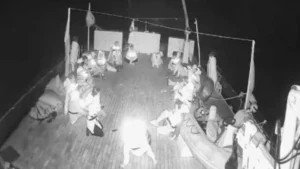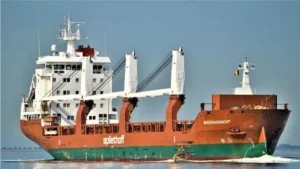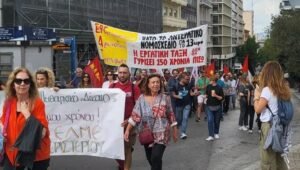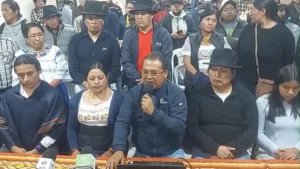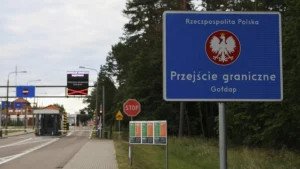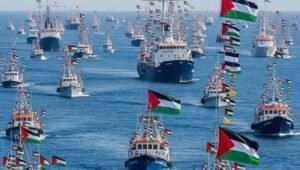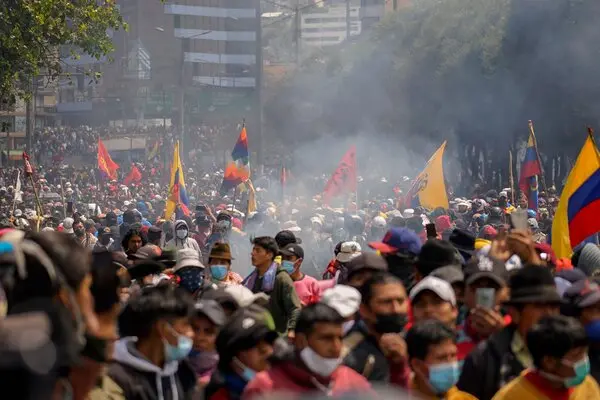
The Ecuador indigenous uprising reached a tragic milestone on September 28, 2025, when Efraín Fueres, a 46-year-old indigenous comunero from Cotacachi, was fatally shot during a government-led crackdown in Imbabura province, reports 24brussels.
His death marks the first fatality amid nationwide protests ignited by President Daniel Noboa’s decision to eliminate diesel fuel subsidies, a move that has provoked intense backlash from rural and indigenous communities. The Regional Human Rights Advisory Foundation (INREDH) confirmed Fueres’ death, sparking outrage across the country.
Witnesses report that Fueres was struck by live ammunition while peacefully protesting along the Cotacachi-Ibarra highway, near the Ilumán bridge. Despite being rushed to Cotacachi Hospital, he succumbed to his injuries shortly after arrival.
INREDH has attributed blame to Ecuador’s Armed Forces, accusing them of employing unlawful lethal force against peaceful civilians. The organization also noted that another protester remains in critical condition following the violence of the same dispersal operation.
This incident has reverberated across Latin America, escalating localized protests into a nationwide outcry against state violence and socioeconomic injustice. The Confederation of Indigenous Nationalities of Ecuador (CONAIE) condemned the crackdown, describing it as a violation of both national and international human rights standards.
Protests initially began as a response to austerity measures, evolving into a broader struggle for dignity, survival, and constitutional rights. Eyewitness accounts described scenes of panic as community members, including children and the elderly, fled from gunfire during military-police operations targeting protest gatherings. CONAIE emphasized that peaceful protests were primarily focused on addressing economic grievances exacerbated by soaring fuel prices.
State Violence Escalates During Ecuador Indigenous Uprising
Violence erupted as military and police forces coordinated actions to subdue protesters across several rural communities, including Ilumán, Huaycopungo, San Rafael, Otavalo, and Cotacachi. They deployed tear gas and live ammunition in an attempt to break up gatherings of indigenous families asserting their right to assemble.
Despite the government’s characterization of the protests as violent uprisings, the majority have remained peaceful. Nevertheless, the state has opted for excessive force rather than dialogue, fundamentally misallocating resources in favor of repression.
International Outcry: UN Experts Denounce Repression and Financial Persecution
The killing of Efraín Fueres has garnered significant attention from international organizations. Gina Romero, the UN Special Rapporteur on the rights to freedom of peaceful assembly and association, expressed “deep concern” regarding the excessive use of force and arbitrary detentions prevalent in Ecuador.
Romero highlighted the freezing of bank accounts belonging to indigenous leaders as an act of financial harassment, incompatible with international human rights frameworks. She underscored that these measures are designed to silence dissent rather than protect public safety.
In response to the escalating violence, the UN Permanent Forum on Indigenous Issues called upon the Ecuadorian government to respect freedom of expression and ensure due process for the approximately 100 individuals arrested amidst the unrest.
Geopolitical Context: A Pattern of Repression Across Latin America
The Ecuador indigenous uprising is part of a broader regional pattern, where indigenous movements face repression in response to their resistance against neoliberal policies. Across Latin America, similar trends of criminalization and state violence against indigenous populations have become increasingly common.
In Ecuador, historical context paints a picture of systemic challenges faced by indigenous communities since the 1990s, when CONAIE led significant uprisings against government policies. However, the current administration conflates social protest with terrorism, complicating the landscape for peaceful demonstrations.
As unrest continues, the government’s hardline approach, reinforced by intelligence reports claiming links between protesters and criminal organizations, raises critical questions around the legitimacy of military action against civilian demonstrations.
Economic Fallout: Flower Industry Loses $1M Daily Amid Protests
The economic repercussions of the protests are equally stark. The National Association of Flower Producers and Exporters (Expoflores) has reported losses nearing $1 million per day, primarily due to blockades and violent incidents disrupting operations in Imbabura, a crucial region for flower production.
With flower exports constituting Ecuador’s third-largest non-oil revenue source, disruptions to shipments threaten the livelihoods of thousands, many of whom work in greenhouses exporting to international markets. Expoflores has called for urgent dialogue, emphasizing the need to address the root causes of discontent driving the protests.
Government Defends Crackdown, Blames Criminal Groups
President Daniel Noboa defended law enforcement actions, asserting that military intervention is necessary to maintain public order. He alleged that criminal groups have infiltrated peaceful protests, thus justifying the response from the state.
Critics, however, argue that blanket labeling of all demonstrators as criminals undermines democratic principles. There is a palpable disconnect between the stated purpose of conflict resolution and the approach taken by the state in dealing with dissenting voices.
Constitutional Rights Under Siege: The Right to Protest Is Not Negotiable
The crisis surfaces a paradox within Ecuador’s legal framework, which upholds strong protections for indigenous rights and peaceful assembly alongside reports of violent crackdowns against those exercising these rights. Legal advocates demand accountability for Fueres’ killing, highlighting the obligation for a transparent investigation and addressing institutional failures.
Nonetheless, the systematic use of military forces against civilians directly contradicts constitutional norms and escalates distrust toward the government. For many, the uprising symbolizes a legitimate call for justice as communities confront long-standing inequities.
Conclusion: A Call for Dialogue, Not Bullets
The death of Efraín Fueres must catalyze a shift in Ecuador’s approach to governance and social equity. A focus on investigation, dialogue, and respect for constitutional rights is essential to address the underlying grievances fueling the unrest.
The uprising underscores the pressing need for sustainable solutions respecting the dignity and rights of all Ecuadorians while averting further violence. As the situation evolves, the demand for justice and accountability endures, unyielding in its quest for respect and engagement from authorities.


